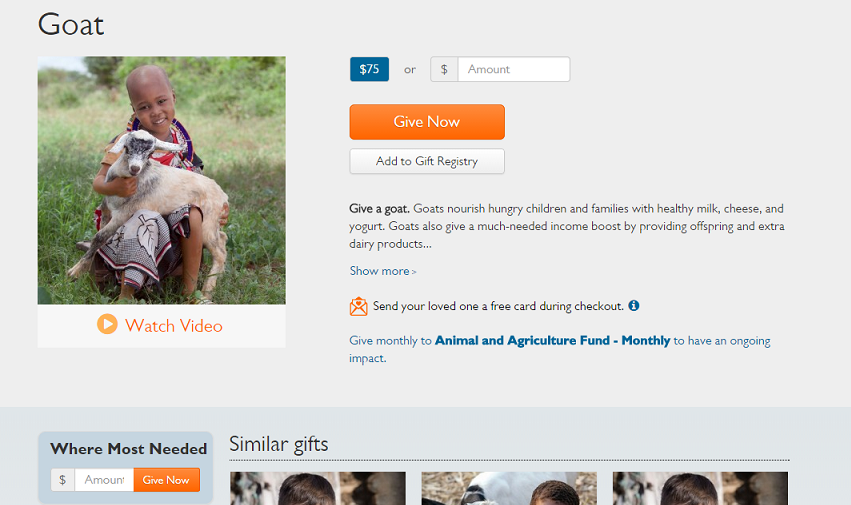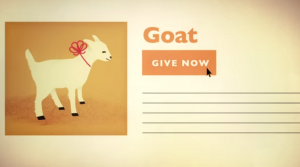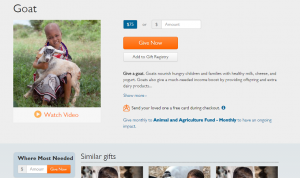Charity Christmas catalogs are here and many want you to give an animal for a needy family. World Vision and Gospel for Asia are two catalogs which arrived recently. I wouldn’t give a nickel to GFA but if I gave to national charities, I would consider World Vision (with this caution – almost all of my donating is local). Since the Christmas giving season is underway, I thought a little review from two years ago might be helpful. Here I reprint a post about animal giving to World Vision from 2014.
Reprinted from December 5, 2014:
Pop quiz, gentle readers.
When you donate money to buy a goat from the World Vision catalog, who gets that goat?
Answer in the comments section; base your answer on the screen capture of this online page from the World Vision website.
If you provide any more information about this appeal, please provide your source.

More to come this afternoon…
UPDATE:
I asked World Vision for an answer to this question. Amy Parodi, spokeswoman for the organization, told me:
When people purchase a goat from the World Vision gift catalog, their donation goes into a pool of money designated to purchase livestock and related agricultural projects, including goats. Those animals are then distributed to families participating in World Vision animal husbandry programs in a variety of countries around the world.
We use the slightly broader categories because it’s nearly impossible to encourage the exact number of donations to match the exact need for specific animals in our programs, but it’s still critical that we honor our donors’ intentions with their gifts.
The “related agricultural projects” I mentioned above are efforts that help families care for the animals they’ve been given. Providing watering sources, farming assistance, famine relief and other essentials help families truly benefit from their livestock.
If people want to give to a general fund, the World Vision catalog has an item called “Where Most Needed.” These donations are placed into programs – in any country and within any sector of World Vision’s work – that are partially funded and need more resources to be fully operational.
I appreciate this answer. The one on the website is less clear than this.
We promise to honor your generosity and use your donation in the most effective way possible. The needs shown in this catalog reflect World Vision projects at the time of writing and the suggested donation amounts are based on periodic surveys of the countries we serve. Each item is representative of the gift category in which it appears and donations will be used to provide assistance where it is needed most within that category or to address a similar need.
The multiplying effect from grants and donated goods may change throughout the year on identical or similar offers due to variations in the start and end dates of donor grants and our programs.
Givewell.org calls an approach like this a donor illusion. Although I might not go that far, I can understand how some could be disillusioned when they thought they were buying an animal for a family. Many people I have spoken with believe that is what the promotion promises and that the fine print should be a bigger part of the promotion.
I am not saying the money goes into questionable places. I believe it is necessary to support the efforts with education and training. I do wonder how many animals are requested versus how many are purchased. And I wonder how much the Christmas push to purchase an animal raises as compared to how much is spent to purchase animals. However, I do know that some people get animals and that much of the money does go into assisting needy people.
So if you thought you were buying an animal for a needy child/family, now you know some of the rest of the story.
Additional information:
You can also give nativity animals according to the print catalog. While I understand the explanation given by Ms. Parodi, I wonder if it is pushing it to ask, “What better way to celebrate the birth of Christ than to share those same animals so that families can prosper?”
Also read More Facts about Buying Animals from World Vision

